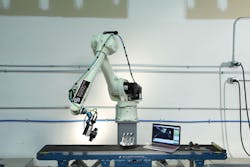Smart camera and vision algorithms combine for robotic vision guidance platform
When a larger automotive OEM required robotic guidance in a smaller, more cost-effective form factor in an assembly process on it’s production line, Recognition Robotics (Elyria, OH, USA; www.recognitionrobotics.com) developed an improved version of its previously-released robotic guidance product.
In 2012, Recognition Robotics introduced its Robeye solution for robot guidance that was designed to mimic the way that humans see. The system uses an industrial camera attached to a robot arm to capture images of part that the robot will be guiding to, and a separate industrial computer processes the images and communicates with the robot’s controller.
Recently, an automotive customer required a system with a smaller footprint, lower cost, and a simpler setup and operation. To provide vision guidance for a robotic arm being used to derack automotive body panels and place them onto a vehicle in the body-in-white part of the vehicle assembly process, Recognition Robotics partnered with ADLINK Technology (New Taipei, Taiwan; www.adlinktech.com) to develop an improved version of Robeye called Robeye All-In-One or RAIO.
Recognition Robotics recently partnered with ADLINK to develop an improved version of Robeye called Robeye All-In-One (RAIO) for an automotive customer that required a system with a vision-guided robot for automotive body panel deracking that offered a smaller footprint, lower cost, and a simpler setup and operation.
The RAIO camera leverages an ADLINK NEON-1020 smart camera, which features the 2 MPixel CMV2000 CMOS image sensor from ams Sensors Belgium (CMOSIS, Antwerp, Belgium; www.cmosis.com). The sensor offers a 5.5 µm pixel size and reaches a frame rate of 120 fps. ADLINK’s smart camera also features an Intel Atom Quad Core processor E3845 1.91GHz, an FPGA co-processor, and runs on Windows or Linux. This architecture, according to ADLINK, reduced the footprint of the Robeye product and provided an IP67-rated “self-contained visual recognition and guidance system.”
Running on the RAIO camera, Recognition Robotics’ vision algorithms were applied to the robotic vision guidance system. The algorithms, according to Recognition Robotics, process images similar to how the human visual cortex functions. From a single 2D image, the system can recognize a part and return the X, Y, Z, Rx, Ry, and Rz location information about the orientation of the part within the robot’s user frame. With this data, the robot is then able to update a preprogrammed path with the corrected offset data of that part’s current location in space.
“The algorithms are based on the human cognitive ability to recognize objects. When I developed these algorithms, I was mimicking the human visual cortex. We’ve used knowledge about human brain function, the point of view of the human eye, and put this into the software realm,” Dr. Simon Melikian, CEO, Recognition Robotics. Recognition Robotic’s RAIO is a lightweight solution that can be mounted directly onto the robotic arm, and because it is a self-contained system, it is easy to remotely interface the RAIO and the robot controller for object teaching, configuration, and execution, according to ADLINK. This capability allows for remote programming and monitoring of multiple RAIO work cells across the manufacturing floor network.
“ADLINK is very well known in the industry. They have been very flexible with us, they worked with us to get exactly what we needed out of an embedded sensor. There were specific features that we talked to ADLINK about, and they made sure we received exactly what we were looking for,” said Bradley Vargo, Robotics Guidance Engineer, Recognition Robotics. — James Carroll, Senior Web Editor.
About the Author

John Lewis
John Lewis is a former editor in chief at Vision Systems Design. He has technical, industry, and journalistic qualifications, with more than 13 years of progressive content development experience working at Cognex Corporation. Prior to Cognex, where his articles on machine vision were published in dozens of trade journals, Lewis was a technical editor for Design News, the world's leading engineering magazine, covering automation, machine vision, and other engineering topics since 1996. He currently is an account executive at Tech B2B Marketing (Jacksonville, FL, USA).
B.Sc., University of Massachusetts, Lowell


